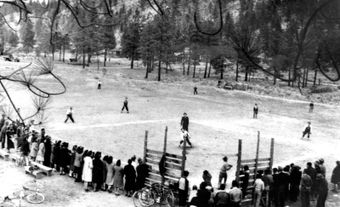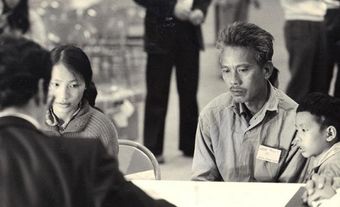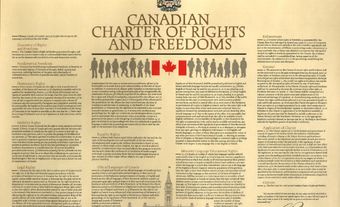The concept of a model minority is a myth and stereotype that was first identified by the discipline of Asian American studies in the 1970s. This academic field of study was developed as a response to the omission and marginalization of Asian Americans in the study of American history. This stereotype depicts Asians as hard working, successful at school and in the workplace, and as economically prosperous. This stereotype has many negative consequences. It divides Asian Canadian communities — which include East Asians, Southeast Asians, South Asians, and Central Asians — and other racialized groups. The model minority myth also overlooks a history of systemic racism towards Canadians of Asian descent and trivializes contemporary problems within Asian Canadian communities. (See also South Asian Canadians; Southeast Asian Canadians; Chinese Canadians; Japanese Canadians.)
The Model Minority Stereotype and Its Racist History
Racial minorities in the United States have often sought to portray themselves in a positive light to combat discrimination. During the 1940s, Asian and Black people sought to earn the respect of the white majority of society. They did so by highlighting their traditional family values, their obedient children, their successful assimilation, their participation in armed forces and their good work ethic. However, as the Black civil rights movement gained traction in the 1960s, the dominant white majority of society only saw an advantage in socially uplifting Asians who portrayed themselves as respectable. By uplifting Asians as a successful, assimilated racial minority, the white majority of society could dismiss the narrative of racial oppression and deny the demands brought forward by Black civil rights activists. This political manoeuvre gave rise to the Asian model minority stereotype.
With the United States and Canada sharing close economic and cultural ties, the model minority stereotype also took root within the Canadian consciousness. According to Gordon Pon, associate professor of social work at Ryerson University, the American model minority stereotype converged with the Canadian tendency to portray Asian Canadians as collectivist and successful. In the Canadian context, argues Pon, the model minority stereotype fuses with Canadian multiculturalism in a way that erases anti-Asian racism. The multicultural perspective on Asian cultures focuses on a narrow and rigid view of Asian cultures. By celebrating surface level aspects of Asian cultural artefacts such as food, costume, and art, along with traditional model minority values, multiculturalism reduces Canadians of Asian descent to one-dimensional beings. It does not account for cultural change, the diversity present within Asian cultures, and for ever-changing diasporic realities. Furthermore, by claiming to be a multicultural country that accepts people of all cultural backgrounds equally, Canada perpetuates the myth that anti-Asian racism does not exist. In fact, Canada has a long history of anti-Asian racism that continues to this day.
Asian Canadian Resistance Against the Model Minority Stereotype
When Asians started being portrayed as a model minority, white policymakers instituted fewer racist policies and modified attitudes towards Asian Americans. In the Canadian context, the Immigration Act of 1967 admitted immigrants into Canada on a point-based system instead of a national citizenship basis (see Immigration Policy in Canada). It allowed highly educated Asian immigrants to enter Canada in large numbers. This migration trend reinforced the model minority stereotype.
Mass media in Canada perpetuated the model minority myth by the way they would describe Asian Canadians in news coverage, but sometimes there was high profile pushback. When a 1979 segment called “Campus Giveaway” aired on W5, a CTV program, Asian Canadians were outraged (see Television). The segment was about how foreign Chinese students were “taking over” Canadian universities. It discussed how the federal government was subsidizing their education, and was denying white Canadian students the opportunity to attend post-secondary education. These claims were found to be unsubstantiated and of a racist nature by the Ad Hoc Committees of the Council of Chinese Canadians Against W5. It was found later on that many of the Chinese faces that were shown as foreign in the segment were actually faces of Canadian students of Chinese origin. Asian Canadian students rallied together to write protest letters to denounce the segment. They were joined by Asian Canadian community leaders in their demonstrations and their denunciations. Under immense pressure from the Asian Canadian community, CTV eventually issued an apology and fired the producer of the segment. The incident brought the Asian Canadian community together and led to the founding of the Chinese Canadian National Council (CCNC), an activist group that is still active today.
In 2010, another racist incident related to the model minority sparked outrage. Maclean’s published an article called “Too Asian?” that lamented the high numbers of Asian students in the country’s top universities. The article’s authors criticized Asian students’ tendencies of being high-achieving hard workers who did not socialize or party. They also explained away the racial imbalance of Canadian campuses by writing that privately educated white students refused to apply to certain universities because they viewed them as “too Asian.” Asian Canadians across the country rallied together to denounce the magazine. Their actions led to cities across Canada — including Toronto, Vancouver, Victoria, Markham and Richmond Hill — to pass motions that denounced the piece and called for an apology. To this day, Maclean’s has refused to apologize for the piece. However, the article sparked a renewed dialogue around anti-Asian racism.
Contemporary Asian Canadian Issues
The model minority stereotype causes significant harm to the Asian Canadian community. Studies published in the Journal and Community Health and the Journal of Mental Health have shown that the pressure to live up to the myth’s perfect ideal has resulted in mental health problems among young Asian Canadians. The poor mental health that results from the stereotype is linked to an increased risk of death by suicide for Asian Canadians.
A 2021 Toronto Star article by Angelyn Francis highlights how the model minority stereotype also creates divisions within the Asian Canadian community by excluding members who do not fit within its confines. This myth leads some members of the community to conform to its unhealthy standards as a survival tactic. The myth can also result in members of the community to shame those who cannot conform or who will not do so. Furthermore, the model minority myth divides Asian Canadians from other racialized communities in Canada. The myth has been used as a tool to dismiss the racism experienced by Black Canadians (see Anti-Black Racism in Canada), Indigenous peoples and other Canadians of colour by upholding Asian Canadians as an example of a successful racialized group in spite of the oppression they live with.
Scholars and journalists have also found that the model minority stereotype does not account for the systemic racism experienced by Asian Canadians. The stereotype does not address the wide income inequality and educational achievement gaps within the Asian Canadian diaspora. It also does not address the rise in hate crimes perpetrated against East Asian Canadians during the COVID-19 pandemic (see also SARS in Canada). The model minority stereotype overlooks the diversity of ethnicities, cultures and languages that comprise Asian Canadian communities. The model minority myth falsely presents Asian Canadians as homogeneous and erases the historical and lived experiences of different Asian Canadian demographic groups.

 Share on Facebook
Share on Facebook Share on X
Share on X Share by Email
Share by Email Share on Google Classroom
Share on Google Classroom








